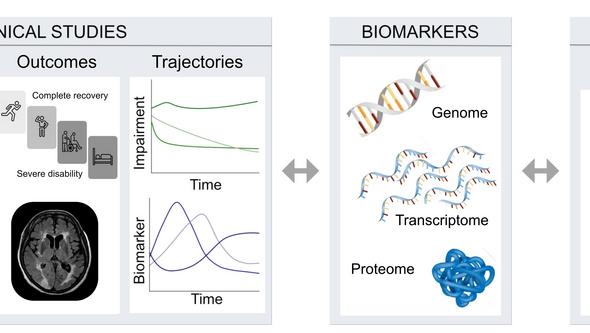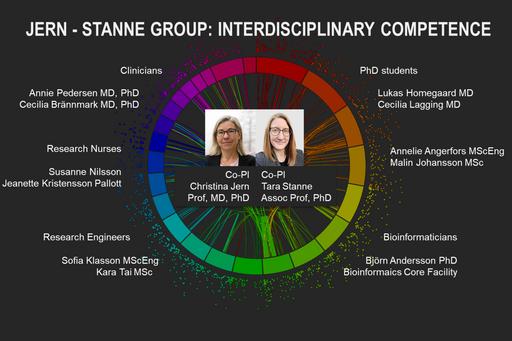
On prothrombotic pathways and blood biomarkers in ischemic stroke: an integrated clinical and experimental study
Short description
Stroke is the second most common cause of death and the most common cause of disability in adults. The most common type of stroke is so-called ischemic stroke, which occurs due to a blood clot in one of the brain’s vessels. Christina Jern's research group focuses on increasing the knowledge of underlying mechanisms in stroke and on factors of importance for post-stroke recovery. We study so-called biomarkers and genetic factors. The long-term goal is to contribute to the development of precision medicine in stroke, i.e. more individualized treatments and interventions in stroke.
Worldwide one in four people will experience a stroke during their lifetime. Stroke is the second most common cause of death and the foremost cause of adult disability. Stroke also imposes a great societal and economic burden. Despite this, there are many gaps of knowledge regarding risk factors, treatments and outcomes.

Stroke is a heterogenous disease and can be caused by a blood clot (ischemic stroke; Fig. 1) or a bleeding (hemorrhagic stroke). Ischemic stroke is the most common (~85% in Sweden) and can be further divided into subtypes based on the site of the blood clot formation. However, in 25% of patients the blood clot source cannot be determined despite a comprehensive clinical work-up (denoted cryptogenic stroke). We and others have shown that the stroke recurrence rate after cryptogenic stroke is substantial, and recurrent strokes continue to account for ~25% of all strokes. Improved secondary prevention represents a unique opportunity to reduce the burden of stroke. However, not knowing the cause of stroke hinders optimal secondary prevention. Increasing knowledge on underlying pathophysiological mechanisms for all stroke types and subtypes, with emphasis on cryptogenic ischemic stroke, is therefore an important aim of our research project (Fig. 2). To achieve this we perform broad blood biomarker profiling studies (e.g. to identify genetic variants, RNAs and proteins) to identify novel pathways and genes of importance for stroke incidence and stroke recurrence.
The outcomes after stroke vary greatly; while some individuals recover, many are left with persistent impairments and stroke is the most common cause of adult disability. Clinical factors such as initial stroke severity, comorbidities and level of rehabilitation received only explain a part of this variation in recovery. There is a need to better understand the molecular mechanisms underlying this variability and another aim of our research project is to identify pathways and genes of importance for different post-stroke outcomes (Fig. 2).

Our research includes both clinical and experimental methodologies and uses a “bi-directional” translational approach; that is to say that findings from our clinical studies are investigated further in the laboratory and vice versa. To achieve this, we have an inter-disciplinary team that includes members with backgrounds such as neurology, clinical genetics, pre-clinical chemistry and biology, biostatistics and engineering.
In the future, the knowledge gained from this project may suggest novel targets for therapy and lay the foundation for individual risk profiling and secondary prevention of ischemic stroke.

Clinical Studies
The Sahlgrenska Academy Study on Ischemic Stroke
This part of the project relies on large, well-characterized cohorts of stroke cases and age- and sex matched community controls: SAHLSIS (inclusion 1998-2013) and SAHLSIS 2 (2015- inclusion ongoing). The original SAHLSIS included cases with ischemic stroke before 70 years of age, but since 2015 both ischemic and hemorrhagic stroke of all ages are included. Strong emphasis is placed on clinical characterization and standardized biobanking of blood, plasma, serum in both studies. We seek blood biomarker profiles (e.g. DNA variants, RNA and protein) associated with specific stroke types and subtypes as well as various outcomes. For this we use two complementary approaches: hypothesis-based (for example prothrombotic pathways) and hypothesis-generating (i.e. multiomic profiling). Genetic studies are performed in collaboration with national and international partners. We are actively engaged in the International Stroke Genetics Consortium (ISGC) and participate in several large multi-center genome wide association studies (GWAS) on stroke. Our group also leads a GWAS on ischemic stroke outcome (the Genetics of Ischemic Stroke Functional Outcome (GISCOME) study.
FIND Stroke Recovery
Data on the time course of recovery and biomarkers after stroke are scarce, and thus we are also performing a prospective longitudinal study, The FIND Stroke Recovery Study. The protocol for this study includes repeated measurements of outcomes to allow for objective measurements of changes in impairments in different domains over time. Neurological deficits as well as cognition, depression, participation, and quality of life are monitored. We also biobank blood, plasma and serum samples at these set time points to enable evaluation of the time course of blood biomarkers (e.g. protein and RNA) in relation to the time course of recovery.
Experimental Studies
The Liver Project
Given the importance of hemostasis (blood clotting) for ischemic stroke, and as a complement to our clinical stroke studies, we perform studies to better understand the regulation of genes encoding hemostatic factors, many of which are synthesized in the liver (Fig. 2). Here we use targeted next generation sequencing (NGS) to identify genetic variants (DNA sequencing) and to quantify mRNA (RNA sequencing) and DNA methylation (bisulfite-sequencing) as well as long-read PacBio Isoform sequencing for RNA isoform identification and characterization. This part of the project is translational and the importance of identified regulatory variants and/or alternative isoforms of interest will be investigated for association with stroke occurrence or outcomes.
Functional Characterization of Genetic Variants
We interrogate in silico datasets to characterize the regulatory potential of genetic variants identified through the studies described above. Variants exhibiting the most promising regulatory potential are taken forward for functional characterization in the lab.
Outreach
The group leader Christina Jern is engaged in several outreach activities regarding stroke, and is member of the Steering Committee of Stroke Centrum Väst (SCV, https://www.gu.se/strokecentrumvast), Fellow of the European Stroke Organisation (FESO https://eso-stroke.org/about-eso/), member of the International Stroke Genetics Consortium (ISGC, https://www.strokegenetics.org/), co-chair of the ISGC Outcomes working group (https://www.strokegenetics.org/node/202), member of the Coordinating Group for Complex Diseases at Genomic Medicine Sweden (GMS https://genomicmedicine.se/en/complex-diseases/).

Christina Jern
Principal Investigator
Affiliation:
Department of Laboratory Medicine,
Institute of Biomedicine

Tara Stanne
Associate Professor (docent), PhD
Co-principal investigator
Affiliation:
Department of Laboratory Medicine,
Institute of Biomedicine
Group members
Annie Pedersen, MD, PhD
Björn Andersson, PhD, statistician
Cecilia Brännmark, MSc, MD, PhD
Annelie Angerfors, engineer, PhD student
Cecilia Lagging, MD, PhD student
Lukas Holmegaard, MD, engineer, PhD student
Malin Johansson, MSc, PhD student
Sofia Klasson, MSc, research engineer
Kara Tai, MSc, research engineer
Robert Månsby, MD
Susanne Nilsson, nurse
Egil Lindahl, med student
Björn Granelli, med student
Fabian Baniamer, med student
Co-workers at the Institute of Neuroscience and Physiology
Katarina Jood, MD, PhD, group leader
Christian Blomstrand, MD, PhD, senior professor